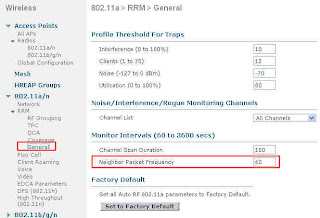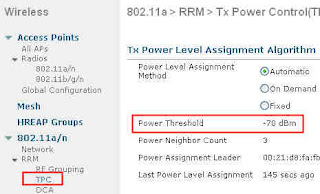To determine the number of neighbouring APs and their power level, the system relies on RRM neighbour messages, sent by all APs every 60 seconds by default, at max power and lowest mandatory rate. All other APs hearing the RRM message forward it to their controller. As each RRM neighbour message is signed, each controller can recognize if it was sent by a known AP in the RF Group and identify the AP along with which APs reported (= heard) the message, with what power level. Smart, he?
Now what can we tune here? 2 things:
- How often the RRM neighbour messages are sent.
- What is the threshold that triggers the RRM algorithm.
Remember the defaults? RRM messages are sent every 60 seconds, and you need 3 neighbouring APs hearing this AP at -70 dBm to trigger the algorithm. You cannot change this "3 APs" value.
To change how often the RRM neighbour messages are sent, from your controller GUI, navigate to Wireless > 82.11a > RRM > General. Change the Neighbor Packet Frequency from 60 to the new interval you want to use. As you can guess, this is done on a per radio basis, do the same for 82.11b/g if you want to.

That's for the RRM neighbour message frequency. The RRM algorithm threshold cannot be changed from the GUI, but from the CLI. In your controller CLI, type:
(Cisco Controller) >config advanced 802.11a tx-power-control-threshold ?
Enter a value between (-50) and (-80)
And change the value to what is best. For example:
Cisco Controller) >config advanced 802.11a tx-power-control-threshold -79
You can of course use the "show advanced 82.11a tx-power-control-threshold" command to verify the current value. This changes the threshold for 82.11a, you need the same command for 82.11b/g if required.
You can see the value of this threshold from the GUI, under Wireless > 82.11a > RRM TPC.
Before:

After!





Hi
ReplyDeleteA quick detail:
"and you need 3 neighbouring Aps heard at -70 dBm"
No, it is per AP doing the TPC calculation, the AP must be heard by 3 Aps.
So, it is not what "you hear", but how "they hear you"
That is why in WLC config analyzer you have both points of views, to analyze better RRM calculations
Javier.
Hi Jerome,
ReplyDeleteJust a comment on this statement "...if any of your AP has only 2 other APs in it's neighborhood (or at least 2 APs heard at -70 dBm or better), the WLC will not change the AP channel or power level."
While it's true that the AP will not change power levels in this scenario, they will change channels. I've tested this in a lab to confirm it's true. So at a remote site with just two APs, they both won't end up on Channel 1 for example.
Regards,
Steve Lilley
Presidio Network Solutions
Thanks Javier and Steve, you are both perfectly right!
ReplyDeleteI corrected the text body accordingly...
Thanks again!
Jerome
Jerome,
ReplyDeleteIs it possible either from the controller, WCS/NCS or from the LAP itself to be able to determine for each access point, how many APs it can here and their RSSI? An example would be, if I can see RRM is not working in an area of a customer's building (i.e. all the APs are set to power level of 1), rather than going out to the area and doing a passive survey to determine the RF coverage of each AP (let's say it is a remote site and this is not easily done), can I look up a table in the controller or on the AP itself that will tell me which other access points this particular AP can here and what the RSSI is. That way, rather than doing a guess and test with the Tx Power threshold, I can definitively say, "set it to -75, rather than -80 because I can see that there are in fact 3 other APs that it can here, it's just that two have an RSSI of -67, while one has an RSSI of -73."
Thanks,
Jeff
Hey Jeff,
ReplyDeleteYep, there is such a command, not from the AP/WCS/NCS, but from the controller CLI:
show ap auto-rf 802.11a| 802.11b is your friend.
For example:
(Cisco Controller) show>ap auto-rf 802.11a 3502a
(go by the bottom of the display, you'll see:)
.../...
Nearby APs
AP 24:b6:57:34:66:c0 slot 1.................. -23 dBm on 64 (10.10.10.20)
AP 24:b6:57:34:96:10 slot 1.................. -17 dBm on 40 (10.10.10.20)
AP d4:d7:48:0d:b7:80 slot 1.................. -17 dBm on 52 (10.10.10.20)
Radar Information
hth
Jerome
You have done really a superb job with your web site. Marvelous stuff is here to read.
ReplyDeleteZero Up 2.0 Review